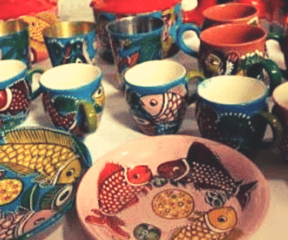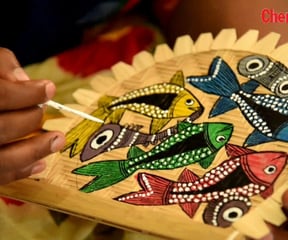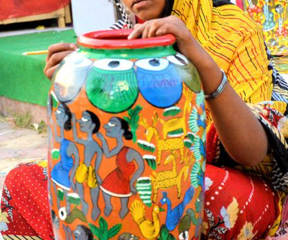Santhal Art - Landscapes of Beauty
A beautiful tribal art of Bihar, Jharkhand and West Bengal






Pic Courtesy: Times of India and Chennai Times
Santhal or Santal art is a charming tribal art-form practised by the Santhal tribe (the third largest tribe of India) of Bihar, Jharkhand and West Bengal – whose origins are believed to date back to the Pre-Aryan times. Their art is a creative expression of their reverence for Mother Nature as they are sustained by forests, and by farming, fishing and hunting. After a hard day's work, the Santhals prefer to relax in the evenings with music and dance in a beautiful close-knit community setting.
Typically painted on a background of lush greenery – the paintings are characterised by their bright and whimsical colors, and depict animals, birds, fishes and humans in a village setting – celebrating daily life. Human figures, animals and birds are usually shown in side profile, with an abundance of musical instruments richly scattered within the paintings.
Santhal paintings would often depict key instruments such as: bamboo flutes called tirio, drums named tamak and tumdak, ankle bells named junko, and fiddles known as banam.
Themes typically include: village folk working in the fields, harvesting, dancing and singing under trees, festive wedding scenes with the bridegroom and bride in palanquins, praying at the temple, village feasts, playing traditional musical instruments, fishing in rivers and lakes, riding in boats, carrying firewood and water-pots, flying kites, riding a bullock cart to the market, etc. These paintings were originally painted on cloth, and on the walls of mud huts to commemorate important events and celebrations.
Santhal art has a direct childlike simplicity that lends it a nostalgic old-world charm. The paintings are often busy with a lot of characters and there is a rhythmic movement in the pictures - one can visualize the action just by looking at the painting! Another characteristic is the absence of a defined colour schema. Animals, birds and humans are all brightly coloured in different hues based on the artist's imagination, giving it an enchanting quality.
Traditionally, Santhal painters were known as Jadu Patua (magical painters) and they painted using natural colours extracted from leaves and flowers, minerals and mud. E.g. geru pathor (a red stone), sheem paata (green leaves of broad beans) and lamp black were widely used – and by mixing the colours, the painters created new shades.
They were called magical painters because they painted to preserve crops, prevent diseases, honour the dead, and so on. Often, the Jadu Patuas would take their scrolls of paintings, and travel from village to village, telling stories using their artwork.
Sri Rabindranath Tagore played a key role in the revival and promotion of this art form at 'Shantiniketan' – where Santhal art, among many others, was also taught. An artists' colony was also established near Shantiniketan. Sri Jamini Roy, the famed artist who combined Western technique and Indian art styles to produce his own signature art, took a special interest in Santhal art and immortalised it through his artistic interpretations.
Today, Santhal art can be found adorning textiles and home decor to meet the needs of modern art connoisseurs, and as souvenirs for tourists. However, despite its rich history, traditional Santhal art is facing a crisis due to a scarcity of patrons.
